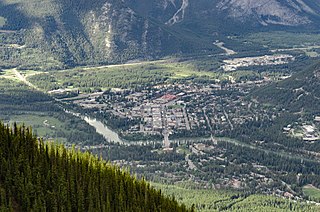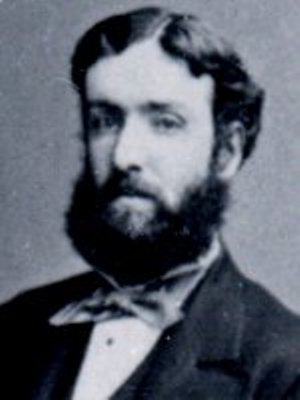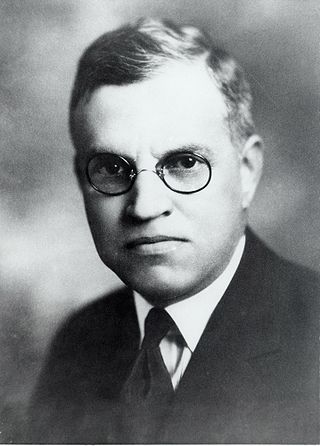
Jasper National Park, in Alberta, Canada, is the largest national park within Alberta's Rocky Mountains, spanning 11,000 km2 (4,200 sq mi). It was established as Jasper Forest Park in 1907, renamed as a national park in 1930, and declared a UNESCO world heritage site in 1984. Its location is north of Banff National Park and west of Edmonton. The park contains the glaciers of the Columbia Icefield, springs, lakes, waterfalls and mountains.

Banff National Park is Canada's oldest national park, established in 1885 as Rocky Mountains Park. Located in Alberta's Rocky Mountains, 110–180 kilometres (68–112 mi) west of Calgary, Banff encompasses 6,641 square kilometres (2,564 sq mi) of mountainous terrain, with many glaciers and ice fields, dense coniferous forest, and alpine landscapes. Provincial forests and Yoho National Park are neighbours to the west, while Kootenay National Park is located to the south and Kananaskis Country to the southeast. The main commercial centre of the park is the town of Banff, in the Bow River valley.

Banff is a resort town in Banff National Park, Alberta, Canada, in Alberta's Rockies along the Trans-Canada Highway, 126 km (78 mi) west of Calgary, 58 km (36 mi) east of Lake Louise, and 1,400 to 1,630 m above sea level.

The culture of Alberta refers to the art, customs, and traditions of the people of Alberta. Alberta entered into Confederation in 1905, placing her in a tie with Saskatchewan as the country's second youngest province. Despite her short history, the province possesses a rich culture. The vastness of the land and variation of geography – which includes mountains, foothills, grassland, parkland, forest, and rockland – have served as important sources of creative inspiration across all art forms. Alberta's primary industries of farming, ranching, and petroleum also play a major part in the province's culture and identity.

Kootenay National Park is a national park of Canada in southeastern British Columbia. The park consists of 1,406 km2 (543 sq mi) of the Canadian Rockies, including parts of the Kootenay and Park mountain ranges, the Kootenay River and the entirety of the Vermilion River. While the Vermilion River is completely contained within the park, the Kootenay River has its headwaters just outside the park boundary, flowing through the park into the Rocky Mountain Trench and eventually joining the Columbia River. The park ranges in elevation from 918 m (3,012 ft) at the southwestern park entrance to 3,424 m (11,234 ft) at Deltaform Mountain.

The Fairmont Chateau Lake Louise is a Fairmont hotel on the eastern shore of Lake Louise, near Banff, Alberta. The original hotel was gradually developed at the turn of the 20th century by the Canadian Pacific Railway and was thus "kin" to its predecessors, the Banff Springs Hotel and the Château Frontenac. The original wooden Rattenbury Wing was destroyed by fire on July 3, 1924, and was replaced by the Barott Wing a year later. The Painter Wing, built in 1913, remains the oldest existing part of the hotel. The Mount Temple Wing, opened in 2004, is the most recent wing and features modern function facilities; these include the Mount Temple Ballroom.

Mount Rundle is a mountain in Canada's Banff National Park overlooking the towns of Banff and Canmore, Alberta. The Cree name was Waskahigan Watchi or house mountain. In 1858 John Palliser renamed the mountain after Reverend Robert Rundle, a Methodist invited by the Hudson's Bay Company to do missionary work in western Canada in the 1840s. He introduced syllabics there—a written language developed for the Cree, as part of his missionary work. He only visited the Stoney-Nakoda of the area around what is now called Mount Rundle in 1844 and 1847.

The Fairmont Banff Springs, formerly and commonly known as the Banff Springs Hotel, is a historic hotel in western Canada, located in Banff, Alberta. The entire town, including the hotel, is situated in Banff National Park, a national park managed by Parks Canada. At an elevation of 1,414 metres (4,640 ft) above sea level, the hotel overlooks a valley towards Mount Rundle, both of which are situated within the Rocky Mountain mountain range.

Sulphur Mountain is a mountain in Banff National Park in the Canadian Rocky Mountains overlooking the town of Banff, Alberta, Canada.

Bruce Price was an American architect and an innovator in the Shingle Style. The stark geometry and compact massing of his cottages in Tuxedo Park, New York, influenced Modernist architects, including Frank Lloyd Wright and Robert Venturi.

Châteauesque is a revivalist architectural style based on the French Renaissance architecture of the monumental châteaux of the Loire Valley from the late fifteenth century to the early seventeenth century.

Canada's grand railway hotels are a series of railway hotels across the country, each a local and national landmark, and most of which are icons of Canadian history and architecture; some are considered to be the grand hotels of the British Empire. Each hotel was originally built by the Canadian railway companies, or the railways acted as a catalyst for the hotel's construction. The hotels were designed to serve the passengers of the country's then expanding rail network, and they celebrated rail travel in style.

Robert Chambers Reamer (1873–1938) was an American architect, most noted for the Old Faithful Inn in Yellowstone National Park. A number of his works are listed on the National Register of Historic Places for their architecture.

Banff Upper Hot Springs are commercially developed hot springs located in Banff National Park in Alberta, Canada, near the Banff townsite. Europeans first became aware of the springs in 1883. As it has been developed since, the hot pool is outdoors and while in the pool, visitors can look across the valley to Mount Rundle. It is located at 1,585 metres (5,200 ft) of elevation, which makes it the highest hot spring in Canada.

The Cave and Basin National Historic Site of Canada is located in the town of Banff, Alberta, within the Canadian Rocky Mountains, at the site of natural thermal mineral springs around which Canada's first national park, Banff National Park, was established.

Walter Joseph Phillips was an English-born Canadian painter and printmaker. He is credited with popularizing the colour woodcut in the style of the Japanese, in Canada.

Norman Kenny Luxton was a pioneer in the Canadian Rockies known as "Mr. Banff". With John Voss, he attempted to sail around the world in an old red cedar Indian dug-out canoe. On his return to Canada, he worked on improving the community of Banff, Alberta and the relationship between its residents and the aboriginal community.

The Banff National Park Pavilion, was designed by Frank Lloyd Wright and Francis Conroy Sullivan, one of Wright's only Canadian students. Designed in 1911, in the Prairie School style, construction began in 1913 and was completed the following year. The pavilion was built on the Recreation Grounds near the south end of the Bow River Bridge on the edge of the town of Banff, itself located within Banff National Park in Alberta. The last of only two Wright designs in Canada, the pavilion was demolished in 1938.
The Alberta Association of Architects published their Chronicle of Significant Alberta Architecture in February 2003 and August 2005. The project's main goal was to ensure that the public, as well as those with a professional interest in the subject, could easily identify architecturally significant structures developed and still standing in Alberta. The project was undertaken in association with the Government of Alberta.

















